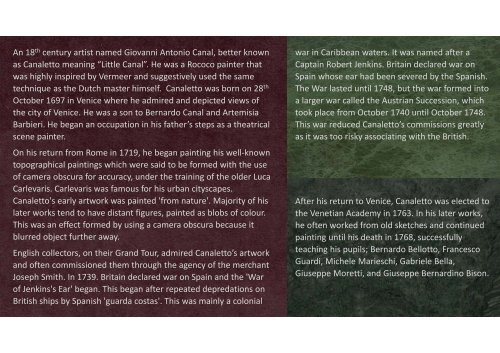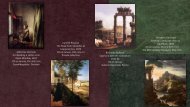Create successful ePaper yourself
Turn your PDF publications into a flip-book with our unique Google optimized e-Paper software.
An 18 th century artist named Giovanni Antonio Canal, better known<br />
as Canaletto meaning “Little Canal”. He was a Rococo painter that<br />
was highly inspired by Vermeer and suggestively used the same<br />
technique as the Dutch master himself. Canaletto was born on 28 th<br />
October 1697 in Venice where he admired and depicted views of<br />
the city of Venice. He was a son to Bernardo Canal and Artemisia<br />
Barbieri. He began an occupation in his father’s steps as a theatrical<br />
scene painter.<br />
On his return from Rome in 1719, he began painting his well‐known<br />
topographical paintings which were said to be formed with the use<br />
of camera obscura for accuracy, under the training of the older Luca<br />
Carlevaris. Carlevaris was famous for his urban cityscapes.<br />
Canaletto's early artwork was painted 'from nature'. Majority of his<br />
later works tend to have distant figures, painted as blobs of colour.<br />
This was an effect formed by using a camera obscura because it<br />
blurred object further away.<br />
English collectors, on their Grand Tour, admired Canaletto’s artwork<br />
and often commissioned them through the agency of the merchant<br />
Joseph Smith. In 1739. Britain declared war on Spain and the 'War<br />
of Jenkins's Ear' began. This began after repeated depredations on<br />
British ships by Spanish 'guarda costas'. This was mainly a colonial<br />
war in Caribbean waters. It was named after a<br />
Captain Robert Jenkins. Britain declared war on<br />
Spain whose ear had been severed by the Spanish.<br />
The War lasted until 1748, but the war formed into<br />
a larger war called the Austrian Succession, which<br />
took place from October 1740 until October 1748.<br />
This war reduced Canaletto’s commissions greatly<br />
as it was too risky associating with the British.<br />
After his return to Venice, Canaletto was elected to<br />
the Venetian Academy in 1763. In his later works,<br />
he often worked from old sketches and continued<br />
painting until his death in 1768, successfully<br />
teaching his pupils; Bernardo Bellotto, Francesco<br />
Guardi, Michele Marieschi, Gabriele Bella,<br />
Giuseppe Moretti, and Giuseppe Bernardino Bison.





